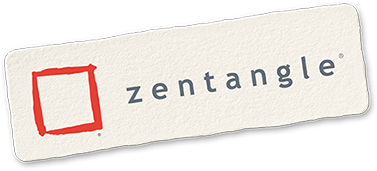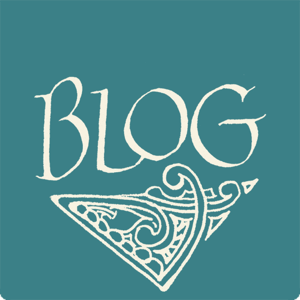Paige Scheinberg, MS, ATR-BC, CZT writes....
I remember the moment I discovered Zentangle®. I was sitting at a computer at my first art therapy internship in graduate school feeling totally overwhelmed and anxious about entering the mental health field and working with people with severe and chronic mental illness. During my short breaks between facilitating art therapy groups and seemingly endless documentation, I would often search for inspiration for new, engaging art processes that could help my clients meet their treatment goals. On this fated day, I unexpectedly discovered an image that was filled with incredible patterns that weaved in and out of each other with such beauty and intricacy. Yet, as I stayed with this image, I imagined how these patterns could be broken down into simple lines and shapes so that almost anyone could make them. After some quick research, I pleasantly discovered that this was exactly what the Zentangle Method is all about – guiding people through a simple, relaxing drawing process that also invites gratitude, acceptance, and creative fun. While beautiful art is often a product of Zentangle, it was really all about the process – just like in art therapy. I couldn’t help but think how meaningful and engaging this could be to share in art therapy sessions – and how much I would enjoy it, too!

In art therapy, we have a saying – “Don’t ask anyone to try or create anything you haven’t experienced or created yourself.” This is especially important as a mental health professional, because people can have drastically different experiences with a creative process depending on their cognitive, physical, and emotional health, past experiences with materials, and even the amount of time given to create (to name just a few considerations). Lucky for me, that has meant I’ve spent years exploring the Zentangle Method through a variety of materials and approaches to better understand what my clients’ potential sensory, cognitive, emotional, and creative experiences would be through different materials, tile designs, and projects.
And, the patterns – oh, how I love the original Zentangle patterns! From the initial process of creating patterns with clients to spending some time observing them afterwards, tangle patterns have become an abundant source of metaphor and symbolism for so many. After some initial reflection and questions, Zentangle patterns have lead my clients and me to many meaningful discussions about navigating life transitions, coping with change, cultivating strengths, savoring the good, and even understanding and influencing brain changes.

One of my first – and most memorable and affirming – experiences with tangling in an art therapy group was with a client in a forensics unit in a state hospital. After living on the unit for a number of years, this young man had experienced art therapy with many art therapists and explained, “I’ve done it all. I’m not really interested anymore.” He occasionally attended groups briefly, but often complained of headaches (likely a part of his auditory hallucinations) and preferred to be alone and walk around the unit for most of the day. While I still felt new to the Zentangle Method, I figured I’d give it a try – what did we have to lose? I told our group I was still learning how to tangle and that we’d discover this process together. That day, this restless young man not only came to the session, but stayed and created the entire group. As we continued to tangle in the weeks to come, his engagement continued, however, his headaches and anxiety seemed to disappear during our groups. He even took on a leadership role in the group for a few sessions, picking out a pattern, practicing it, and then guiding our group through the creative process.
After one of these groups with him, I found myself at my computer again searching for Zentangle, but this time, I emailed Rick and Maria. I told them about my work as a new art therapist and how empowering, relaxing, and effective I was finding the Zentangle Method – and asked what I could do to get more involved. As fate would have it, a spot unexpectedly opened in the CZT training a few months later – and I’ve been finding ways to incorporate my love and enthusiasm for Zentangle into my work as a mental health professional ever since.
From schools and hospitals to museums and people’s homes, I’ve found the Zentangle Method to help people reduce anxiety and stress, increase focus and motivation, improve self-concept, mood, and motor skills, feel a sense of pride, accomplishment, and peace, and build connections with others and their creative selves. It brings me such joy to know that all of this is accessible to so many at almost anytime. All you really need is a square piece of paper, a pen, and a focus on the process – and, of course, our breath, gratitude, and an invitation to our other dear Bijousims.

These days, you can most often find me offering Zentangle at an adult outpatient cancer center as part of an array of services that I offer through our Integrative Oncology Division. By integrating the Zentangle Method into art therapy and mindfulness sessions, I have been able to help cancer survivors and caregivers relax during infusion treatments, stay grounded during life transitions, explore creativity and problem-solving, and even feel joy and peace while healing from treatment, in the hospital, or processing the unexpected. As a mental health professional, I have also found the Zentangle Method to be invaluable for my own creativity and well-being. It’s not uncommon for me to grab a piece of paper and a pen for some tangling between sessions to feel the benefits of my own creative, compassionate moments of breath, appreciation, ease, and enjoyment.
IG / FB @shineonwithpaige
SHINEONconsulting.com
--- + ---
Thank you to all who shared your thoughts on our last blog, Tangling Your Own Conclusions. We have randomly selected Eileen Larsen to receive a new Zentangle MantraBand! Please send your snail mail address to julie@zentangle.com.



Great article. I absolutely agree. Zentangle Art Therapy satisfies our brains desire to seek pleasurable and repeated activities. https://how2havefun.com/pakistan-news/zentangle-art
neat on
It’s truly inspiring to read about the profound impact that art therapy can have on individuals. Art therapy is a powerful tool that allows individuals to express themselves in ways that might be challenging but help to unlock deep-seated emotions and experiences. Thanks for sharing; this post is really helpful. However, I also found this article on effective expressive art therapy activities, which I think can be very helpful to anyone looking forword to art therapy.
https://yourmentalhealthpal.com/effective-art-therapy-activities/
sanjeev on
Paige was my Zentangle teacher for a couple of years. I’m so proud of all she has accomplished — and will accomplish!
Carol Levy on
Art is so incredibly important in life and it has been my personal goal to expose people to art in all of it’s forms. It’s amazing to see how many adults think that they cannot make art. I found Neurographic art and Zentangle in the same week, and I combine the two. I have shared them both with more people than I could count.
Your account here, shows how very important this all is, as art is an unspoken language where real healing that can take place, which is priceless. Thank you for sharing your experiences with us.
When I first heard Rick and Maria explaining how this all came to be, I was so happy to hear that someone wanted to make these beautiful forms accessible to everyone. It’s absolutely marvelous beyond words.
Lore Murdock on
Kim VanZyll on
ildica Boyd on
Grey Walker on
SHEILA RYAN 5/21
Sheila Ryan on
LynnSenn on
An inspiring read – her interest in the Zentangle Method for both herself n her clients. Proof in life!
Nancy on
Rimona Gale on
Kathy Y. on
Linda Rios on
While I cannot call myself an art therapist, I, too, can see the healing nature of the Zentangle Method. My most precious feedback was from a friend with Stage 4 cancer who told me as I was leaving, “I haven’t thought of cancer in the last hour and a half. Thank you.”
Linda M Dochter on
Hayley Billington on
What a beautiful story, helping people to survive in sad times. And the power of Zentangle doesn’t need to be told, it shows. Respect to you Paige.
Irene Lammerse on
Mary Margaret Yahnke on
Julie Crosby on
Julie Crosby on
Roslyn Badcock on
Roslyn Badcock on
Art therapy is such a great place for Zentangle! As a retired occupational Therapist, I rather wish I had known Zentangle when I was working. Both in the schools & the nursing homes where I worked, focus, relaxation, & fine motor skills would all benefit. Another benefit I can see is that of gaining self-confidence.
Sue Cutter on
Thank you so much for sharing how impactful Zentangle has been in your practice! Once I learned about the method and its focus on gratitude and mindfulness, I was hooked. The opportunities for healing are the often- unsung gifts of this practice.
Alisa Anderson on
Zentangle is my go to method of relaxation. Stress and anxiety sometimes hits me hard. The only solution for me is Zentangle. I go to YouTube and search for my favorite teachers it works wonderful. Thanks 😊
Miriam Martinez on
Zentangle is my go to method of relaxation. Stress and anxiety sometimes hits me hard. The only solution for me is Zentangle. I go to YouTube and search for my favorite teachers it works wonderful. Thanks 😊
Miriam Martinez on